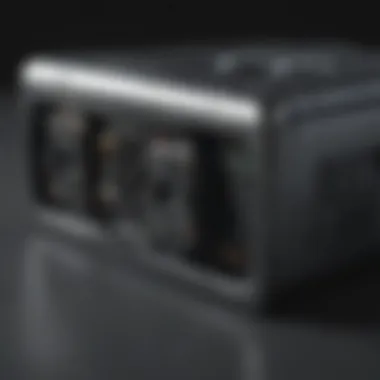A Deep Dive into MacBook Chargers: Types and Tips


Intro
Understanding the intricacies of MacBook chargers is essential for both casual users and dedicated Apple enthusiasts. These charging devices are not just mere accessories; they play a pivotal role in the overall user experience. A reliable charger can significantly affect the performance and longevity of your MacBook. This article aims to offer a well-rounded perspective on various aspects related to MacBook chargers.
Through a thorough exploration of charger types, compatibility, troubleshooting, and maintenance tips, we aim to empower users with knowledge. The implications of charging technology on device longevity and performance will also be discussed. Readers can expect a detailed analysis that combines technical jargon with accessible language, ensuring comprehension at all levels.
Product Overview
Apple has been at the forefront of innovation, and its charging devices reflect that ethos. The primary charger series for MacBook includes the 30W USB-C Power Adapter, 61W USB-C Power Adapter, 87W USB-C Power Adapter, and the 96W USB-C Power Adapter. Each of these is designed to meet specific power requirements of various MacBook models.
Key Features and Specifications
- Efficiency: Each adapter provides optimal energy transfer with minimal waste, enhancing charging efficiency.
- Versatility: The USB-C format allows for universal compatibility with numerous other devices, from smartphones to tablets.
- Compact Design: The lightweight nature of these chargers makes them ideal for portability without compromising power.
Available Variants
These chargers come in distinct wattage options, which correspond to different MacBook models. For instance, the 30W adapter is suitable for the MacBook Air, while the 87W adapter is designed for the larger MacBook Pro models. The black and white finish offers a sleek look, though customer preference for colors may vary.
Compatibility Matters
The compatibility of chargers is a crucial factor. Each MacBook model has a designated wattage it requires for optimal performance.
- MacBook Air: Requires the 30W USB-C adapter.
- MacBook Pro 13-inch: Utilizes the 61W adapter.
- MacBook Pro 15-inch: Functions best with the 87W adapter.
- MacBook Pro 16-inch: Necessitates the 96W adapter.
Using an underpowered charger can lead to slower charging, potentially limiting device performance. Conversely, exceeding wattage tolerance might pose safety risks, including overheat. Understanding your specific model's requirements is therefore vital.
Troubleshooting Common Issues
Problems can arise with any electronic device, and MacBook chargers are no exception. Here are typical issues and how to address them:
- No Charge: Check the connection of the charger to the MacBook and the power source.
- Slow Charging: Ensure you are using the appropriate wattage charger for your model.
- Overheating: Make sure there is sufficient airflow around the charger and check if the charger remains plugged in for extended periods.
Generally, if issues persist, consult Apple's support channels for expert advice.
Maintenance Tips
Maintaining your MacBook charger can prolong its lifespan and efficiency.
- Regular Cleaning: Dust and debris can accumulate. Clean the charging ports gently.
- Avoid Tension: Do not bend the charger excessively. Keeping the cable taut can lead to internal damage.
- Temperature Control: Store the charger in a cool, dry place to prevent overheating.
By following these simple practices, you can extend the life and performance of your charger.
Implications for Device Longevity and Performance
The type and quality of the charger can have a significant impact on the longevity and overall performance of your MacBook. A reliable charger ensures efficient charging cycles, helping maintain the battery's health.
- Battery Lifespan: Constant use of appropriate chargers minimizes wear on internal battery components.
- Performance Levels: Optimal charging prevents performance degradation in intensive tasks, ensuring that your MacBook remains responsive and effective.
This section underscores the importance of selecting the right charger and maintaining it properly.
End


In the rapidly changing landscape of technology, understanding the nuances of your MacBook charger is an invaluable asset. With the right knowledge, users can ensure their devices operate effectively and efficiently. This guide intends to equip readers with the necessary insights for a superior charging experience either at home or on the go.
Understanding MacBook Chargers
Understanding MacBook chargers is a fundamental aspect of ensuring your device operates efficiently and effectively. With various charger types available, it is crucial to choose the correct one to meet the power demands of different MacBook models. An appropriate charger not only affects charging speed but also contributes to the overall lifespan of the device.
Being informed about the different types, specifications, and potential compatibility issues among chargers can enhance user experience significantly. Knowledge in this area empowers MacBook owners to optimize performance. This section will elaborate on essential considerations regarding power needs and the available types of chargers.
Overview of MacBook Power Needs
MacBooks demand specific power requirements that vary across models. The wattage of the charger directly correlates to these needs. For instance, lightweight models like the MacBook Air typically require less power than the more powerful MacBook Pro. Understanding these needs helps avoid issues like slow charging or reduced battery life, thereby ensuring proper usage and reduced wear over time.
Each model has a different wattage requirement, which can usually be found on the original charger or in specifications online from Apple.
Types of MacBook Chargers
Various types of chargers cater to the distinct power needs of MacBook devices. They can be generally categorized into three main types: MagSafe Chargers, USB-C Chargers, and Third-Party Charging Solutions.
MagSafe Chargers
MagSafe Chargers are designed specifically for earlier MacBook models. The unique aspect of MagSafe is its magnetic connector that securely attaches to the device while safely detaching if pulled. This prevents accidental drops and damage to the laptop. The key characteristic of MagSafe Chargers lies in their ease of use and practicality. They also provide a stable power source with consistent wattage levels.
A significant benefit of MagSafe is its lightweight construction, making it easy to carry. However, it is essential to note that these chargers are not compatible with newer MacBook models that use USB-C technology, limiting their usage to older devices only.
USB-C Chargers
USB-C Chargers are currently predominant across most new MacBook models from Apple. Their main characteristic is versatility, as they can charge other devices too, which provide the user with multiple charging options. Also, they support power delivery, which allows faster charging compared to traditional chargers.
An essential feature of USB-C is its reversible design, making it user-friendly. The advantage of using USB-C is clear – owners can utilize the same charger for multiple devices, reducing clutter. One minor drawback could be the reliance on adapters for connecting to non-USB-C accessories, which can be an inconvenience for some users.
Third-Party Charging Solutions
Third-Party Charging Solutions include chargers made by brands not owned by Apple. These options are often available at lower price points, which is appealing. The main characteristic is the availability of various designs and wattages, catering to different users' needs.
A unique feature is the variety that comes with third-party chargers, allowing for customizing setups. However, a notable disadvantage is the risk associated with compatibility and safety. Low-quality third-party options can lead to overheating, which might damage the MacBook over time.
Using chargers that are not certified by Apple may void warranty and can harm your device, hence proceed with caution when selecting third-party options.
Compatibility Issues
Understanding compatibility is vital when it comes to MacBook chargers. As MacBooks evolve, so do the specifications for charging. Ensuring that your charger aligns with your MacBook model can affect the device's performance, longevity, and safety. This section will highlight how to identify your MacBook model, discuss the compatibility between different models, and point out the risks associated with using incompatible chargers.
Identifying Your MacBook Model
Identifying your MacBook model begins with examining the physical device. Most MacBooks have a model identifier, visible under the Apple logo in the top-left corner of the screen on the "About This Mac" section. This detail can help you determine the specifications your device requires. You can also find the model number printed on the bottom casing of the MacBook.
Additionally, different models often have distinct charging requirements. A thorough understanding of which model you possess simplifies the process of selecting the correct charger. You can cross-reference this information with Apple's official documentation to ensure accuracy.
Charger Compatibility Across Models
Charger compatibility varies across MacBook generations. For instance, recent models predominantly use USB-C chargers, while older models rely on MagSafe technology. Apple designed each charging solution to meet specific power needs while ensuring efficient performance.


Here are some key points regarding compatibility:
- USB-C Chargers: Generally, newer devices can utilize USB-C chargers, offering versatility across several devices, including iPads and some smartphones.
- MagSafe Chargers: These are specific to older MacBook models, delivering a unique magnetic connection that minimizes the chances of accidental disconnection.
- Cross-Model Compatibility: It's essential to check wattage ratings. A 61W USB-C charger may work with a MacBook Air, but using a lower wattage can lead to slow charging or battery issues.
Potential Risks of Using Incompatible Chargers
Using an incompatible charger can present several risks. These may include damage to the MacBook’s battery and even the device's internal circuits.
- Battery Drain: Insufficient wattage can cause the battery to drain faster than it charges.
- Overheating: Some third-party chargers may lack adequate safety features, leading to overheating during use.
- Void Warranty: Utilizing a non-certified charger can void warranties and eligibility for repair services.
Important Reminder: Always ensure that the charger you are using is certified and compatible with your specific MacBook model. Taking the time to verify this information can save you from costly damages in the future.
Charger Specifications
Charger specifications encompass a variety of technical details that are crucial for the performance and efficiency of MacBook chargers. Understanding these specifications helps users make informed decisions about charging devices, ensuring compatibility and optimal charging experience. This section aims to explore key elements such as wattage, cable length, and durability considerations.
Understanding Wattage
Wattage is a fundamental aspect of charging devices. It represents the amount of power that the charger delivers to the MacBook. Each MacBook model requires a specific wattage for effective charging. For example, the 13-inch MacBook Pro typically uses a 61-watt charger, while the 15-inch model requires an 87-watt charger. Using a charger with insufficient wattage may result in slower charging times or ineffective charging altogether. Conversely, using a charger with higher wattage than required can risk overheating and potentially damage the battery over time.
When selecting a charger, it is important to check the specifications of your device. Using the correct wattage ensures that the charging process is safe and efficient. It’s also beneficial to look for chargers certified by Apple, as these meet strict performance standards.
Cable Length and Durability Considerations
Cable length and durability are also significant factors to consider when selecting a charger. The length of the charging cable affects how and where you can use it. Shorter cables can limit flexibility, while longer cables can facilitate charging from a distance. This can be particularly important in a workspace where outlets are not conveniently located.
Durability is equally important. A reliable cable should withstand daily wear and tear. Cables that are too thin may be prone to fraying or breaking, leading to potential charging issues. Look for cables with reinforced edges or those made from more robust materials. Investing in quality cables can prevent replacement costs and ensure consistent performance.
Key Points: Always match the charger's wattage with your MacBook's requirements. Choose a cable length that suits your workspace, and opt for durable options to maintain effective charging.
Troubleshooting Charging Issues
Charging issues with MacBooks can be frustrating, but understanding them is vital for maintaining device performance and longevity. Troubleshooting helps in diagnosing problems and implementing solutions before they escalate. Addressing charging problems can also prevent damaging hardware, which is often costly to repair or replace. Therefore, knowing how to effectively troubleshoot charging issues is necessary for every MacBook owner.
Common Charging Problems
Several typical charging problems arise with MacBook devices. Here are some of the most frequent ones:
- Charger not recognized: Sometimes, your MacBook might not recognize the charger. This could be due to a faulty connection, dirt in the ports, or an incompatible charger.
- Slow charging: If your MacBook takes longer than usual to charge, it could indicate a problem with the charger or the MacBook’s battery health.
- Overheating: A charger or MacBook getting excessively hot during charging can signify underlying issues. This may require immediate attention to avoid damage.
Identifying these issues early can often lead to simple fixes, such as cleaning the ports or replacing the charger.
Diagnosing Electrical Issues
Electrical issues are a significant contributor to charging troubles. Properly diagnosing them involves several steps:
- Inspect the charger: Check for any visible damage. Look for frayed wires or signs of overheating.
- Test different outlets: Sometimes, the issue might not be with the charger itself. Switching outlets might reveal if there is a problem with your electrical source.
- Check for software issues: Sometimes the problem can lie in the system settings. Updating macOS or resetting SMC (System Management Controller) might help.
Understanding electrical issues can aid significantly in addressing the charging problems.
Working with Apple Support


If troubleshooting does not resolve the issue, involving Apple Support is a prudent choice. Their support team has access to advanced diagnostic tools and extensive knowledge about MacBook hardware.
- Gather relevant information: Before contacting support, gather details about your MacBook model, purchase date, and descriptions of the problems.
- Describe the troubleshooting steps taken: Provide Apple Support with a clear account of the steps taken to troubleshoot. This information can save time and lead to faster solutions.
- Consideration of warranty options: If your MacBook is still under warranty, inquire about repair services or replacements. Knowing your warranty status can sometimes save considerable costs.
Best Practices for Charger Maintenance
Maintaining your MacBook charger is crucial for the longevity and efficiency of both your charger and your device. Proper care can prevent damage, extend lifespan, and ensure optimal performance. As technology evolves, so does the necessity of correctly managing the devices we rely on daily. This section discusses essential practices that every MacBook user should consider.
Care and Handling of Your Charger
Proper handling of your charger can make a significant difference. Here are crucial points to follow:
- Avoid Bending the Cable: Excessive bending can lead to fraying and internal damage. Always handle the cable gently and avoid tight loops.
- Keep it Clean: Dirt and dust can accumulate on the connector and in the ports. A clean charger ensures proper connection and prevents electrical issues. Use a soft, dry cloth to wipe the surfaces.
- Store Appropriately: When not in use, avoid hanging or placing heavy objects on the charger. Instead, store it in a drawer or a designated storage space to prevent accidental damage.
By following these simple guidelines, you not only preserve the physical integrity of the charger but also enhance its efficiency in delivering power.
Environmental Considerations
The impact of electronic waste is a growing concern, and Macs can contribute to this issue at the end of their lifecycle. Here are some environmental pointers:
- Recycling Options: When your charger is no longer functional, explore recycling options. Many electronics stores offer e-waste recycling services. This prevents chargers from entering landfills where they can leach harmful substances.
- Energy Efficiency: Using your charger responsibly can conserve energy. Unplug the charger when not in use. Apple chargers are designed for efficiency but being mindful reduces overall power consumption.
"Taking small steps in the maintenance of chargers can lead to significant positive impacts over time."
Choosing to act responsibly illustrates a commitment to both personal technology care and environmental stewardship. It is pertinent to balance efficiency and sustainable practices as part of your everyday tech use.
Future Trends in Charging Technology
The charging technology landscape is evolving rapidly, particularly regarding MacBook chargers. Knowing the trends in charging technology not only enhances user experience but also informs user decisions about future purchases. These advancements focus on improving efficiency, convenience, and sustainability, which are vital for the modern user who relies heavily on their devices daily.
Advancements in Fast Charging
Fast charging technology has made significant strides in recent years. This innovation is centered around reducing the time it takes to charge devices. Apple has integrated features like fast charging in newer models of MacBooks, allowing users to quickly restore power and maintain productivity.
Fast charging mechanisms typically involve higher wattage outputs, which allow the battery to draw more power in less time. The transition from standard charging to fast charging is reflected in the battery design and technology, maximizing charge cycles without degrading battery life. Users should note that while fast charging is convenient, continual use may lead to increased heat generation. Thus, users need to ensure adequate ventilation during charging to mitigate heat issues.
Another notable development is the enhancement of charging cables. Apple's 61W and 96W USB-C power adapters, for example, enable faster charging for compatible MacBook models, ultimately ensuring that users can rely on their devices without prolonged downtime.
Wireless Charging Developments
Wireless charging has been a growing trend across many devices, and MacBooks are gradually adopting this technology. While it is less prevalent compared to smartphones, advancements in wireless charging suggest it will become more common in future MacBook models. The essence of wireless charging lies in the convenience afforded by eliminating the need for cables, which can enhance the user experience significantly.
Recent developments, like the Qi standard for wireless charging, demonstrate successful implementations of wireless power transfer. This system allows for charging without physical connections, thus reducing wear on ports. Nonetheless, wireless charging for laptops, such as MacBooks, still faces hurdles in efficiency and power output. Typically, the current wireless solutions provide slower charging speeds compared to wired options.
Key Takeaways
Understanding the key takeaways from this article is crucial for anyone looking to maximize their experience with MacBook chargers. The various sections explore essential aspects of MacBook charging, from types and compatibility to maintenance and future trends in technology. Each element discussed serves to enhance your user experience, ensuring you are not only aware of how to choose the right charger but also how to look after it.
Summarizing Important Points
In summary, the following points are vital:
- Types of Chargers: Familiarity with different charging types—MagSafe, USB-C, and third-party options—enables users to select the appropriate charger for their specific device and needs.
- Compatibility: Understanding how to identify your MacBook model and the specific charger it requires can prevent potential issues down the line. Compatibility is not just about fitting plugs; it involves recognizing wattage requirements and cable specifications.
- Troubleshooting: Knowing common charging problems, diagnosing potential electrical issues, and effective communication with Apple Support can save time and stress. Each MacBook's charging system can encounter unique challenges, and being prepared to address them is invaluable.
- Charger Maintenance: Maintaining your charger prolongs its life span and ensures reliable performance. Proper care involves understanding cable handling and considering environmental effects, which are often overlooked in daily use.
- Future Trends: Keeping an eye on advancements in charging technology, including fast and wireless charging developments, can lead to better resource use and an overall enhanced user experience.
"Knowledge is power; understanding your devices can significantly improve their longevity and performance."
By grasping these main ideas, readers will be better equipped to make informed decisions. In a world increasingly reliant on technology, knowing how to manage your MacBook's charging system is increasingly essential.















